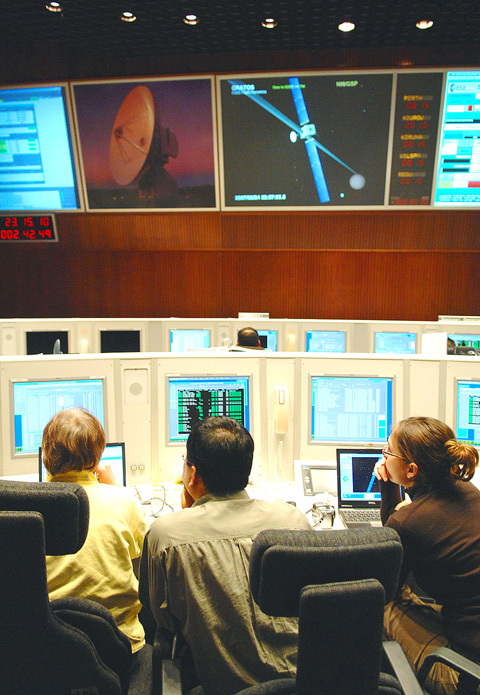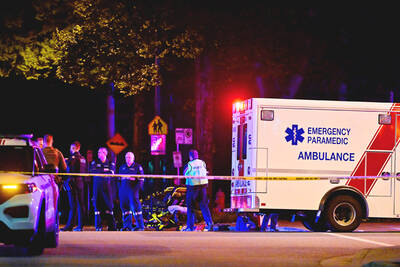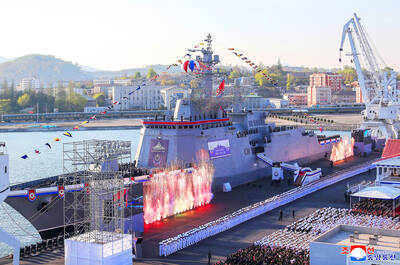A European spacecraft racing through the asteroid belt skimmed past a 10km space rock on Friday to carry out its first scientific work in a decade-long trek into the Solar System, mission controllers said.
In a minutely choreographed operation, the 1 billion euro (US$1.45 billion) unmanned probe Rosetta — launched in 2004 by the European Space Agency (ESA) — came within about 800km of an unusual asteroid called (2867) Steins, a distance that is a hair’s breadth in space terms.
Its goal was to get rare, close-up photographs and surface scanning of an asteroid, part of the intriguing debris left over from the building of the Solar System.

PHOTO: AP
The encounter took place 360 million kilometers from home as Rosetta zipped through the asteroid belt between Mars and Jupiter, on its way to a rendezvous with Comet 67P/Churyumov-Gerasimenko in 2014.
Rosetta switched on 11 instruments to scan the rock as it flashed by at 8.6kps, or 30,720kph, using an optical navigation system to keep automatically on course, ESA said in a live blog of the operation. The spacecraft had been instructed to make a flip so as to get the best view of the asteroid and this caused a planned break in radio contact of around 80 minutes.
When a NASA ground station relayed the message that it had picked up signals from Rosetta after the flyby, the entire team at mission control “let out a huge cheer,” blog editor Daniel Scuka wrote.
Rosetta is four and a half years into a 6.5 billion-kilometer journey that will cause it to loop Earth three times and Mars once, using the planet’s gravity as a slingshot to build up speed so that it can make the meeting with the comet.
It had been roused from hibernation for the meeting with Steins.
Asteroids are a source of deep scientific interest because of the clues they offer into the physical composition of the planets and the impact of the harsh environment of space.
Understanding their structure, density, orbit and spin is also useful for helping Earth to defend itself against any rogue rock that is deflected onto a collision course with our planet. Scientists will have to determine whether it will be safer to nudge any potential threat out of harm’s way or to blow it up, and accurate knowledge will be crucial for making this decision.
Steins falls into a so-called Type E asteroid, composing mainly silicates and basalts, but about which very little is known in detail. In addition to scanning Steins’ shape and reflectivity with powerful cameras, Rosetta used infrared spectrometry to get a fix on the chemical composition of its surface and monitored whether the asteroid was leaving any dust or emitting gas.
The first pictures of the flyby were expected to arrive back at mission control in Darmstadt, Germany, at about noon yesterday, followed by data from other instruments.

Archeologists in Peru on Thursday said they found the 5,000-year-old remains of a noblewoman at the sacred city of Caral, revealing the important role played by women in the oldest center of civilization in the Americas. “What has been discovered corresponds to a woman who apparently had elevated status, an elite woman,” archeologist David Palomino said. The mummy was found in Aspero, a sacred site within the city of Caral that was a garbage dump for more than 30 years until becoming an archeological site in the 1990s. Palomino said the carefully preserved remains, dating to 3,000BC, contained skin, part of the

TRUMP EFFECT: The win capped one of the most dramatic turnarounds in Canadian political history after the Conservatives had led the Liberals by more than 20 points Canadian Prime Minister Mark Carney yesterday pledged to win US President Donald Trump’s trade war after winning Canada’s election and leading his Liberal Party to another term in power. Following a campaign dominated by Trump’s tariffs and annexation threats, Carney promised to chart “a new path forward” in a world “fundamentally changed” by a US that is newly hostile to free trade. “We are over the shock of the American betrayal, but we should never forget the lessons,” said Carney, who led the central banks of Canada and the UK before entering politics earlier this year. “We will win this trade war and

‘BODIES EVERYWHERE’: The incident occurred at a Filipino festival celebrating an anti-colonial leader, with the driver described as a ‘lone suspect’ known to police Canadian police arrested a man on Saturday after a car plowed into a street party in the western Canadian city of Vancouver, killing a number of people. Authorities said the incident happened shortly after 8pm in Vancouver’s Sunset on Fraser neighborhood as members of the Filipino community gathered to celebrate Lapu Lapu Day. The festival, which commemorates a Filipino anti-colonial leader from the 16th century, falls this year on the weekend before Canada’s election. A 30-year-old local man was arrested at the scene, Vancouver police wrote on X. The driver was a “lone suspect” known to police, a police spokesperson told journalists at the

North Korean leader Kim Jong-un has unveiled a new naval destroyer, claiming it as a significant advancement toward his goal of expanding the operational range and preemptive strike capabilities of his nuclear-armed military, state media said yesterday. North Korea’s state-run Korean Central News Agency (KCNA) said Kim attended the launching ceremony for the 5,000-tonne warship on Friday at the western port of Nampo. Kim framed the arms buildup as a response to perceived threats from the US and its allies in Asia, who have been expanding joint military exercises amid rising tensions over the North’s nuclear program. He added that the acquisition